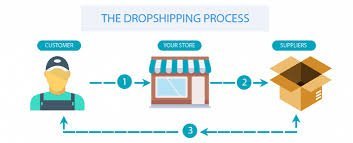What is Dropshipping?
Dropshipping is a business model that enables you to act as the intermediary between customers and product suppliers. Based on the image below, you can see that the process involves promoting products, attracting customers, and bringing orders to suppliers.

Here’s why it’s appealing:
Let’s summarize the dropshipping process:
While platforms like AliExpress are widely known, there are other sources worth exploring:
Dropshipping is a business model that enables you to act as the intermediary between customers and product suppliers. Based on the image below, you can see that the process involves promoting products, attracting customers, and bringing orders to suppliers.

Here’s why it’s appealing:
- No need to manufacture products: Suppliers handle production.
- No need to stock inventory: Goods remain at the supplier's warehouse.
- No need to ship products: Suppliers manage delivery directly to customers.
How Do You Profit?
The essence of dropshipping lies in buying products at wholesale prices (as a collaborator) and selling them at retail prices. The profit margin typically ranges from 25% to 60%, depending on the product and supplier.Let’s summarize the dropshipping process:
- Choose Products: Research and find suppliers who can provide good prices, reliable shipping, and fast delivery times (e.g., AliExpress, Taobao).
- Select Sales Channels: Promote your products on platforms like eBay, Amazon, Etsy, Lazada, Shopee, or through your own website using Facebook Ads or Google Ads.
- Customer Orders: A customer buys from you at your listed price (market price).
- Place Supplier Orders: Forward the order and payment to your supplier at their collaborator rate.
- Order Fulfillment: The supplier packs and ships the product directly to your customer.
Choosing Products and Suppliers
This is the most challenging and essential part of dropshipping. Just like traditional retail, you need to define the type of products you want to sell and find suppliers.While platforms like AliExpress are widely known, there are other sources worth exploring:
Popular Supplier Platforms
- DOBA (doba.com)
- A US-based platform with a subscription fee. DOBA offers suppliers for books, electronics, baby products, fashion, DVDs, games, perfumes, and more.
- Banggood (banggood.com)
- Similar to AliExpress but with warehouses in multiple countries for faster shipping. Banggood also offers affiliate programs with attractive benefits.
- Listia (listia.com)
- A platform for exchanging or donating used goods, where you can profit from shipping fees.
- iOffer (ioffer.com)
- Known for a wide range of products, from fashion items to collectible stamps and coins.
- Bonanza (bonanza.com)
- A niche site for decorative items and DIY products.
- Etsy (etsy.com)
- Focuses on handmade goods, jewelry, and crafts.
The Pros and Cons of Dropshipping
Advantages
- Low Startup Costs: No need to invest in inventory or warehouses.
- Flexibility: Work from anywhere with an internet connection.
- Wide Product Range: Test and sell various products without committing to inventory.
Challenges
- Supplier Dependency: Delays or poor-quality products can harm your reputation.
- High Competition: Many sellers reduce profit margins to stay competitive.
- Limited Customer Experience: You can’t control packaging, delivery times, or product quality.
Practical Tools for Dropshipping
Leverage the following tools to streamline your operations:- Shopify: Build your online store and integrate it with suppliers.
- Oberlo: Automate the process of importing products from AliExpress to Shopify.
- Zendrop: A reliable platform for fast shipping and managing supplier relationships.
Final Tips for Success
Dropshipping isn’t a "get-rich-quick" scheme. Here are some tips for long-term success:- Start with small, lightweight products that are easy to ship.
- Focus on building your brand to stand out in the competitive marketplace.
- Always monitor your suppliers and maintain good customer service.

